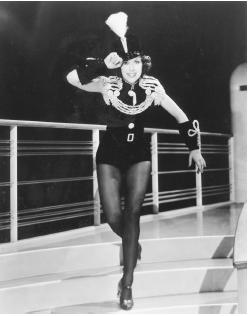Eleanor Powell
From Wikipedia, the free encyclopedia
Birth name Eleanor Torrey Powell
Born November 21, 1912(1912-11-21)
Springfield, Massachusetts, U.S.
Died February 11, 1982 (aged 69)
Beverly Hills, Los Angeles, California, U.S.
Occupation Actress & Dancer
Spouse(s) Glenn Ford (1943-1959)
Children Peter Ford
Official site
http://classicmoviefavorites.com/powell/
Eleanor Torrey Powell (November 21, 1912 - February 11, 1982) was an American film actress and dancer of the 1930s and 1940s, known for her exuberant solo tap dancing.
Biography
Eleanor Torrey Powell was born in Springfield, Massachusetts. A dancer since childhood, she was discovered at the age of 11 by the head of the Vaudeville Kiddie revue, Gus Edwards. When she was 17, she brought her graceful, athletic style to Broadway, where she starred in various revues and musicals. During this time, she was dubbed "the world's greatest tap dancer" due to her machine-gun footwork, and in the early 1930s appeared as a background performer in a couple of early, inconsequential musical films.
Road to Hollywood
In 1935, the leggy, fresh-faced Powell made the move to Hollywood and did a specialty number in her first major film, George White's 1935 Scandals which she later described as a disaster due in part to her accidentally being made up to look like an Egyptian due to a mix-up prior to filming her scene. The experience left her unimpressed with Hollywood. Nonetheless, she was courted by MGM, but initially refused their offers of a contract. Reportedly, Powell attempted to dissuade the studio by making what she felt were unreasonable salary demands, but MGM agreed and she finally accepted. The studio groomed her for her future stardom making minimal changes in her makeup and conduct.
Film stardom
She was well-received in her first starring role in 1935's Broadway Melody of 1936 (in which she was supported by Jack Benny and Frances Langford), and delighted 1930s audiences with her endless energy and enthusiasm, not to mention her stunning dancing. According to dancer Ann Miller, quoted in the "making-of" documentary about That's Entertainment! III, MGM was headed for bankruptcy in the late 1930s, but the films of Eleanor Powell, particularly Broadway Melody of 1936 were so popular they made the company profitable again. Miller also credits Powell for inspiring her own dancing career, which would eventually lead her to become an MGM musical star a decade later.
Powell would go on to star opposite many of the decade's top leading men such as Jimmy Stewart, Robert Taylor, Fred Astaire, George Murphy, Nelson Eddy, and Robert Young. Films she made during the height of her career in the mid-to-late 1930s co-starred these men and others and included Born to Dance (1936), Rosalie (1937), Broadway Melody of 1938 (1937), Honolulu (1939), and Broadway Melody of 1940 (1940). All of these movies featured her amazing solo tapping, although her increasingly huge production numbers began to attract criticism. Her characters also often sang, but Powell's singing voice was usually (but not always) overdubbed (this would also happen to one of Powell's successors, Cyd Charisse). Broadway Melody of 1940, in which Powell starred opposite Fred Astaire, featured an acclaimed musical score by Cole Porter. Together, Astaire and Powell danced to Porter's "Begin The Beguine", which is considered by many to be one of the greatest tap sequences in film history. According to accounts of the making of this film, including a documentary included on the DVD release, Astaire was somewhat intimidated by Powell, who was considered at the time the only female dancer capable of out-dancing Astaire. In his autobiography Steps in Time, Astaire remarked: "She 'put 'em down like a man', no ricky-ticky-sissy stuff with Ellie. She really knocked out a tap dance in a class by herself."
Decline in popularity
Following Broadway Melody of 1940 Powell was sidelined for many months following a gall stone operation and things changed somewhat for the worse, at least as far as Powell's movie career was concerned. 1941's Lady Be Good gave Powell top billing and a classic dance routine to "Fascinatin' Rhythm", but Robert Young and Ann Sothern were the actual stars of the film. The same happened with Red Skelton in Ship Ahoy (1942) and I Dood It (1943), although in Ship Ahoy her character nonetheless played a central role in the story, and Powell's dance skills were put to practical use when she manages to tap out a morse code message to a secret agent in the middle of a dance routine.
She was signed to play opposite Dan Dailey in For Me and My Gal in 1942, but the two actors were removed from the picture during rehearsals and replaced by Gene Kelly and Judy Garland. Later, production of a new Broadway Melody film that would have paired Powell with Kelly was also cancelled.
She parted ways with MGM in 1943 after her next film, Thousands Cheer, in which she appeared only for a few minutes to perform a specialty number (as part of an all-star cast), and the same year married Canadian-born lead actor Glenn Ford. She danced in a giant pinball machine in Sensations of 1945 (1944) for United Artists, but this picture was a critical and commercial disappointment, Powell's performance overshadowed by what was to be the final film appearance of W.C. Fields. Powell retired from the cinema afterwards to concentrate on raising her son, actor Peter Ford, who was born that year (although she did appear in a couple of documentary-style short subjects about celebrities in the late 1940s). Overseas audiences did get to see one additional Powell dance performance in 1946, however, when the compilation The Great Morgan was released, which included a number that had been cut[1] from Honolulu.
In 1950, Powell returned to MGM one last time for a cameo in Duchess of Idaho, starring Esther Williams. Appearing as herself in a nightclub scene, a hesitant Powell is invited to dance by Van Johnson's character, and she begins with a staid, almost balletic performance until she is chided by Johnson for being lazy. She then strips off her skirt, revealing her famous legs, and proceeds to perform a "boogie-woogie"-style specialty number very similar to the one she performed in Thousands Cheer seven years earlier. Williams, in her autobiography The Million Dollar Mermaid, writes of being touched watching Powell rehearsing until her feet bled in order to make her brief cameo as perfect as possible.
Later career: TV and stage
After Duchess of Idaho, Powell returned to private life. In May 1952, she emerged as a guest star on an episode of Four Star Revue with Danny Thomas and June Havoc. Around this time, she was ordained a minister of the Unity Church and later hosted an Emmy Award-winning Sunday morning TV program for youth entitled The Faith of Our Children (1953 - 1955). Her son, Peter Ford, was a regular on this show and would later find his own success as a rock and roll singer and as an actor. In 1955, Powell made her last-ever film appearance when she appeared in Have Faith in Our Children, a three-minute short film produced for the Variety Club of Northern California in which Powell asked viewers to donate to the charity. The short, which other than its title had no relation to the TV series, marked the only time Powell appeared on screen with her husband, Glenn Ford.
Powell divorced Ford in 1959, and that year, encouraged by Peter, launched a highly-publicized nightclub career, maintaining her good figure and looks well into middle age. Her live performances continued well into the 1960s. During the early 1960s she made several guest appearances on variety TV programs, including The Ed Sullivan Show and The Hollywood Palace.
Reintroduction
Powell was reintroduced to audiences in the popular That's Entertainment! documentary in 1974, and its sequels That's Entertainment Part II (1976) and That's Entertainment! III (1994) which spotlight her dancing from films such as Broadway Melody of 1940, Lady Be Good, and Born to Dance.
Eleanor Powell died of cancer at the age of 69, and was interred in the Hollywood Forever Cemetery in Hollywood.
In more recent years most of Powell's films have lapsed into relative obscurity, with only Broadway Melody of 1940 currently available on DVD in North America as of 2006, although two of her production numbers from Broadway Melody of 1936 were included as bonus features on the 2002 special edition DVD release of Singin' in the Rain, and a clip from Honolulu can be glimpsed in a documentary included as a bonus feature with the 2005 DVD release of The Wizard of Oz. In addition, the three That's Entertainment films are also available on DVD. That's Entertainment! III is notable for including behind-the-scenes footage of her "Fascinatin' Rhythm" routine from Lady Be Good. Her films play regularly on the cable network Turner Classic Movies.
In February 2007, Warner Home Video announced plans to release a boxed DVD set of Eleanor Powell's musical films by year end.[2]








 [/quote]
[/quote] 